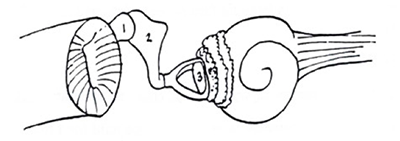Otosclerosis is a hereditary ear condition whereby the third middle ear bone, known as the stapes, becomes stuck and cannot vibrate freely, as it is intended to do in order to transmit sound into the inner ear (see label 3 in Figure 1). This leads to a form of hearing loss called a conductive hearing loss. This bony process can also invade the inner ear capsule, resulting in another type of hearing loss known as sensorineural (nerve) hearing loss. Stapedotomy is a procedure that aims to replace the stapes bone with a prosthetic.

The approach into the middle ear is via a small incision above the ear canal called an endaural incision. The eardrum is lifted up and the middle ear is entered and explored. To replace the stapes (bone 3 in Figure 2), the top half of the bone is removed (see Figure 2) using a laser. Afterwards, a small opening is made through the footplate of the stapes again using a laser and a teflon piston-type prosthesis is used to reconstruct the defect.

This operation does not alter the bony process itself, and does not prevent the ear from potentially undergoing further sensorineural hearing loss in the future.
Those undergoing a laser stapedotomy will have 2-3 dissolvable sutures on the incision. Both types of incisions can be cared for by applying Polysporin® twice a day over the incision.
For the vast majority of stapedotomy surgeries, the gel packing in the external ear is usually soaked with blood from the operation. This is completely normal. Sometimes, cotton in the ear canal will also be soaked with blood, and this is normal as well.
Do not touch or remove the packing in the ear canal. Please try to keep your ear dry at all times until proper healing or the time frame given to you by your surgeon.
To minimize stress on the operation site, do not lift weights greater than 25 lbs. for 4-6 weeks after the surgery. You are also to avoid flying for 4-6 weeks.
Coughing, straining, sneezing, and blowing your nose should also be done as little as possible; if you must cough or sneeze, do so with your mouth open as wide as possible to minimize the pressure.
Any significantly extra pressure can potentially dislodge the prosthesis, which will reduce the rate of success. Most people who perform little physical activities at work can resume work in approximately one week.
Flyncare offers affordable, high-quality medical care to international and domestic patients. Ranked in the top 10+ hospitals in Delhi, we’ve served over 3000 patients worldwide. As a premier medical tourism company in India.